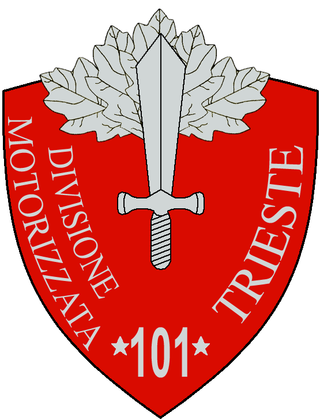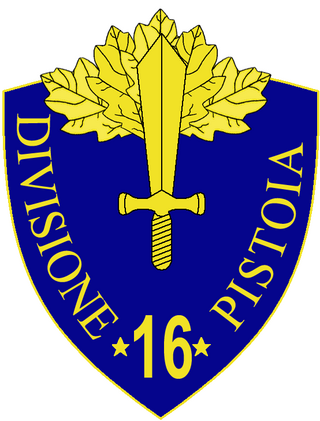
The 132nd Armored Division "Ariete" was an armored division of the Royal Italian Army during World War II. It was formed in 1939 as the second armored division after the 131st Armored Division "Centauro". The division fought in the Western Desert Campaign until being destroyed during the Second Battle of El Alamein and declared lost due to wartime events on 8 December 1942.

The 27th Infantry Division "Brescia" was an infantry division of the Royal Italian Army during World War II. The Brescia was named after the city of Brescia in Lombardy. The Brescia was classified as an auto-transportable division, meaning it had some motorized transport, but not enough to move the entire division at once.

101st Motorized Division "Trieste" was a motorized infantry division of the Royal Italian Army during World War II. The Trieste was formed in 1939 and named for the city of Trieste. The division and its infantry and artillery regiments were based in Piacenza, while the 9th Bersaglieri Regiment was based until 1940 in Treviso and then moved to Cremona to be closer to the division. In September 1941 the Trieste was transferred to Libya for the Western Desert Campaign. The division was decimated in the Second Battle of El Alamein, but was rebuilt with the survivors of destroyed divisions. The Trieste then participated in the Tunisian Campaign until Axis forces in Tunisia surrendered to allied forces on 13 May 1943.

The 17th Infantry Division "Pavia" was an infantry division of the Royal Italian Army during World War II. The Pavia was formed in on 27 April 1939 and named after the city of Pavia. The Pavia was classified as an auto-transportable division, meaning it had some motorized transport, but not enough to move the entire division at once. The Pavia had its recruiting area and regimental depots in the Romagna and its headquarters in Ravenna. Its two infantry regiments were based in Cesena (27th) and Ravenna (28th), with the division's artillery regiment based in Ravenna. Shortly after its formation the division was sent to Sabratha in Italian Libya. It participated in the Western Desert campaign and was destroyed during the Second Battle of El Alamein.

The 131st Armored Division "Centauro" was an armored division of the Italian Army during World War II. The division was formed in April 1939 by expanding the I Armored Brigade. The division's name came from the mythological race of half human-half horse creatures named Centaurs. The division participated in the invasion of Albania, Greco-Italian War, and invasion of Yugoslavia. In August 1942 the division was sent to Libya to participate in the Western Desert Campaign. After the Axis defeat at the Second Battle of El Alamein the division retreated with the German-Italian Panzer Army to Tunisia, where the division participated in the Tunisian Campaign. On 18 April 1943 the division was disbanded due to the losses suffered in the Battle of El Guettar.

133rd Armored Division "Littorio" was an armored division of the Royal Italian Army during World War II. The division's name derives from the fasces carried by the lictors of ancient Rome, which Benito Mussolini had adopted as symbol of state-power of the fascist regime. Sent to North Africa in January 1942 for the Western Desert Campaign the division was destroyed in the Second battle of El Alamein in November 1942.

The 9th Infantry Division Pasubio was an infantry division of the Royal Italian Army during World War II. The Pasubio was classified as an auto-transportable division, meaning it had some motorized transport, but not enough to move the entire division at once. The division was formed as an infantry division in 1934, reorganized as auto-transportable division in 1939 and mobilized in August 1940. It was named for the battles on Pasubio during World War I. Its 79th Infantry Regiment and 8th Artillery Regiment were made up of men from Verona, while the ranks of the 80th Regiment were filled with men from Mantua. Its I CC.NN. Battalion "Sabauda" was made up of Blackshirt volunteers from Turin.

80th Infantry Division "La Spezia" was an infantry division of the Royal Italian Army during World War II. The La Spezia was formed on 15 November 1941 and named for the city of La Spezia. The La Spezia division was the only air-transportable division of the army and earmarked for the planned invasion of Malta. In November 1942 the division was sent to Libya to participate in the North African Campaign. On 13 May 1943 the La Spezia surrendered to Allied forces in Tunisia.

The 1st Infantry Division "Superga" was an infantry division of the Royal Italian Army during World War II. The Superga was classified as a mountain infantry division, which meant that the division's artillery was moved by pack mules instead of the horse-drawn carriages of line infantry divisions. Italy's real mountain warfare divisions were the six alpine divisions manned by Alpini mountain troops. The Superga recruited primarily from central Piedmont and was based, together with its two infantry regiments, in Turin, while the 5th Artillery Regiment was based in Venaria Reale. The division was and named for the Superga hill near Turin, where members of Italy's Royal House of Savoy were buried in the Basilica of Superga.

The 16th Infantry Division "Pistoia" was an infantry division of the Royal Italian Army during World War II. The division was named after the city of Pistoia and initially an infantry division, but reorganized to a fully motorized division in 1941. Consequently on 10 October 1941 the division was renamed 16th Motorized Division "Pistoia". The Pistoia had its recruiting area in the central Emilia-Romagna and its headquarters in Bologna. Its two infantry regiments were based in Bologna (35th) and Modena (36th), with the division's artillery regiment based in Bologna.

The 136th Armored Legionary Division "Centauro" was an armored division of the Royal Italian Army during World War II. The division had been formed in June 1942 as 1st CC.NN. Armored Division "M", but was renamed after the fall of the fascist regime in July 1943. In September 1943 it was in training near Rome and was disbanded by the Germans after the announcement of the Armistice of Cassibile.

The 18th Infantry Division "Messina" was an infantry division of the Royal Italian Army during World War II. The Messina was named for the city of Messina and based primarily in the Marche region, where it also recruited most of its troops. The division's headquarter and 93rd Infantry Regiment were based in Ancona, the 94th Infantry Regiment in Fano, and the 2nd Artillery Regiment in Pesaro.
The 136th Armored Division "Giovani Fascisti", also known in English as the Young Fascists Division or merely the Young Fascists, was an infantry division of the Royal Italian Army during World War II.

After World War II the Italian Army had two units named "Centauro": from 1952 to 1986 the Armored Division "Centauro" and from 1986 to 2002 the Armored Brigade "Centauro". Both units were successor to the World War II era 131st Armored Division "Centauro". The units' name came from the mythological race of half human-half horse creatures named Centaurs.

The 5th Bersaglieri Regiment is an inactive unit of the Italian Army last based in Albenga in Liguria. The regiment is part of the Italian Army's infantry corps' Bersaglieri speciality and was last operationally assigned to the Armored Division "Ariete". The regiment was formed in 1861 by the Royal Italian Army with preexisting battalions. During World War I the regiment served on the Italian front.

The 31st Tank Regiment is an inactive tank regiment of the Italian Army, which was based in Lecce in Apulia and last operationally assigned to the Mechanized Brigade "Pinerolo". The regiment was formed in July 1937 by the Royal Italian Army and assigned to the I Armored Brigade. In April 1939, the regiment moved from Siena to Tirana in occupied Albania. In winter 1940-41 the regiment fought in the Greco-Italian War and in 1941 it participated in the Invasion of Yugoslavia. In November 1942, the regiment was sent to Libya, where it fought in the Western Desert campaign and then in the Tunisian campaign. In April 1943 the regiment was disbanded due to the heavy losses it had suffered in the Battle of El Guettar. The regiment was immediately reformed in Italy, but it saw no further action, until German forces disbanded it after the announcement of the Armistice of Cassibile on 8 September 1943.

The 131st Tank Regiment is an inactive tank regiment of the Italian Army, which was based in Persano in Campania and last operationally assigned to the Bersaglieri Brigade "Garibaldi". The regiment was formed in July 1941 by the Royal Italian Army and assigned for a short time to the 131st Armored Division "Centauro". In January 1942, the regiment became an autonomous unit and was transferred to Sicily, where it fought against allied forces, which had landed on the island on 9 July 1943. The remnants of the regiment were disbanded by German forces after the Armistice of Cassibile was announced on 8 September 1943.

The 92nd Infantry Regiment "Basilicata" is an inactive unit of the Italian Army last based in Foligno. The regiment is named for the region of Basilicata and part of the Italian Army's infantry arm.

The 91st Infantry Regiment "Basilicata" is an inactive unit of the Italian Army last based in Potenza. The regiment is named for the region of Basilicata and part of the Italian Army's infantry arm.

The 131st Artillery Regiment "Centauro" is an inactive field artillery regiment of the Italian Army, which was based in Vercelli in Piedmont. Originally an armored artillery regiment of the Royal Italian Army, the regiment was assigned during World War II to the 131st Armored Division "Centauro", with which the regiment fought in the Tunisian campaign. During the Cold War the regiment was assigned to the Armored Division "Centauro" and from 1986 the Armored Brigade "Centauro". The regiment was disbanded in 2001. The regimental anniversary falls, as for all Italian Army artillery regiments, on June 15, the beginning of the Second Battle of the Piave River in 1918.


















